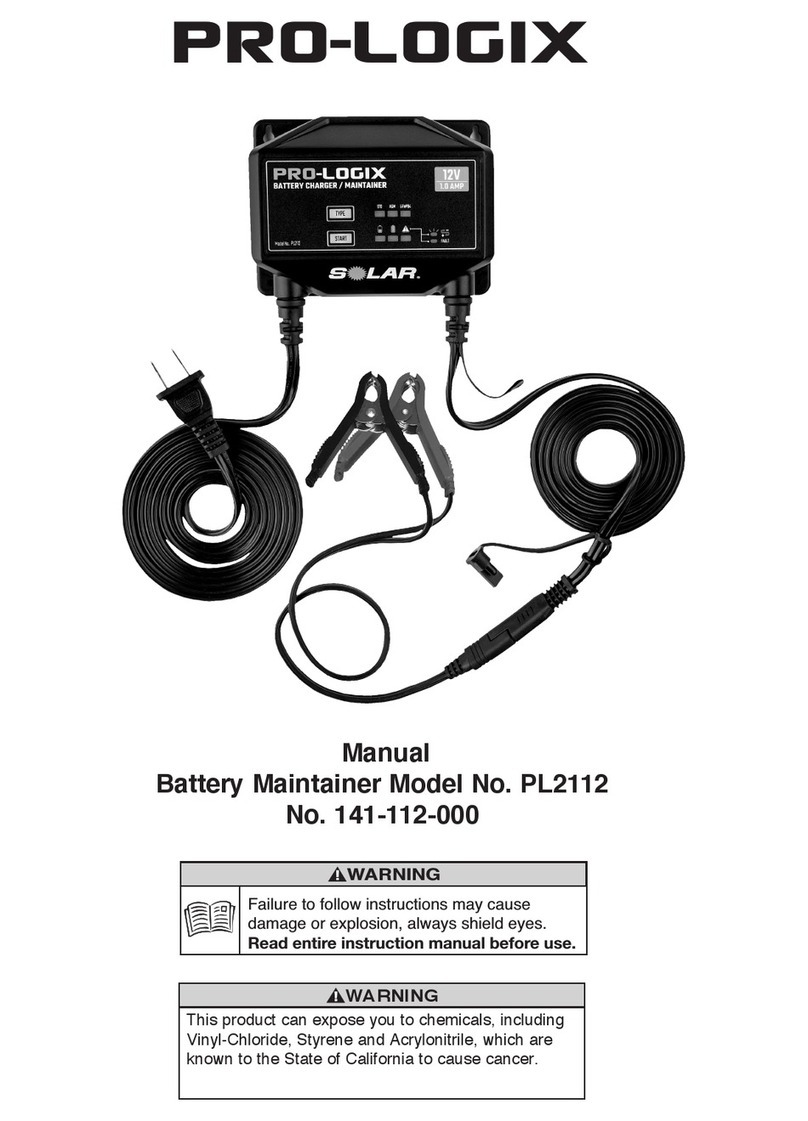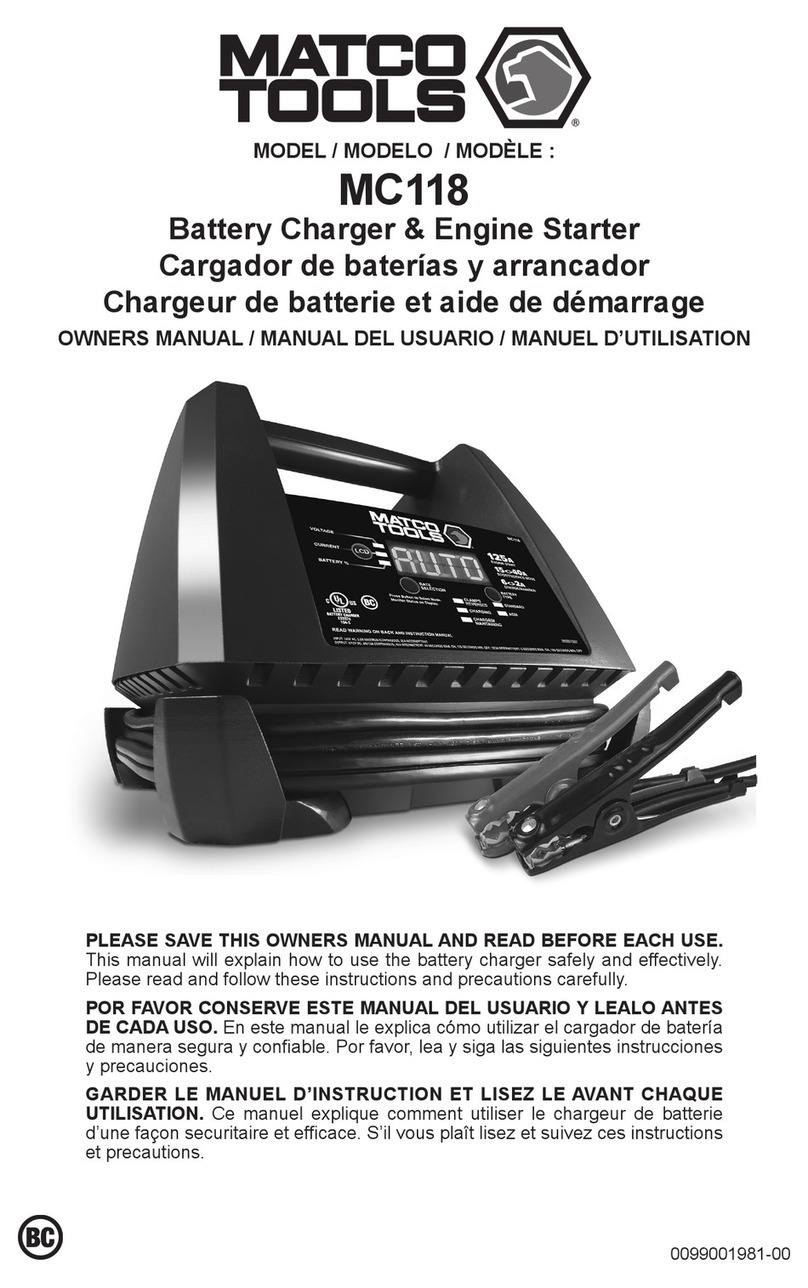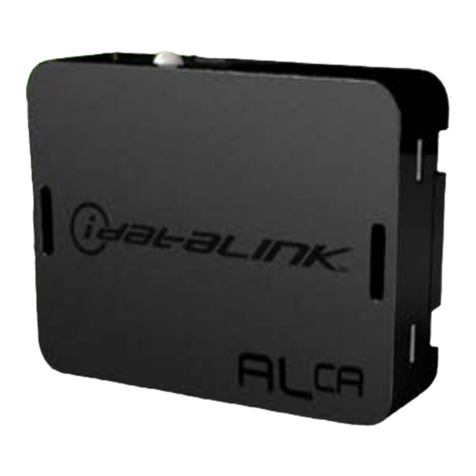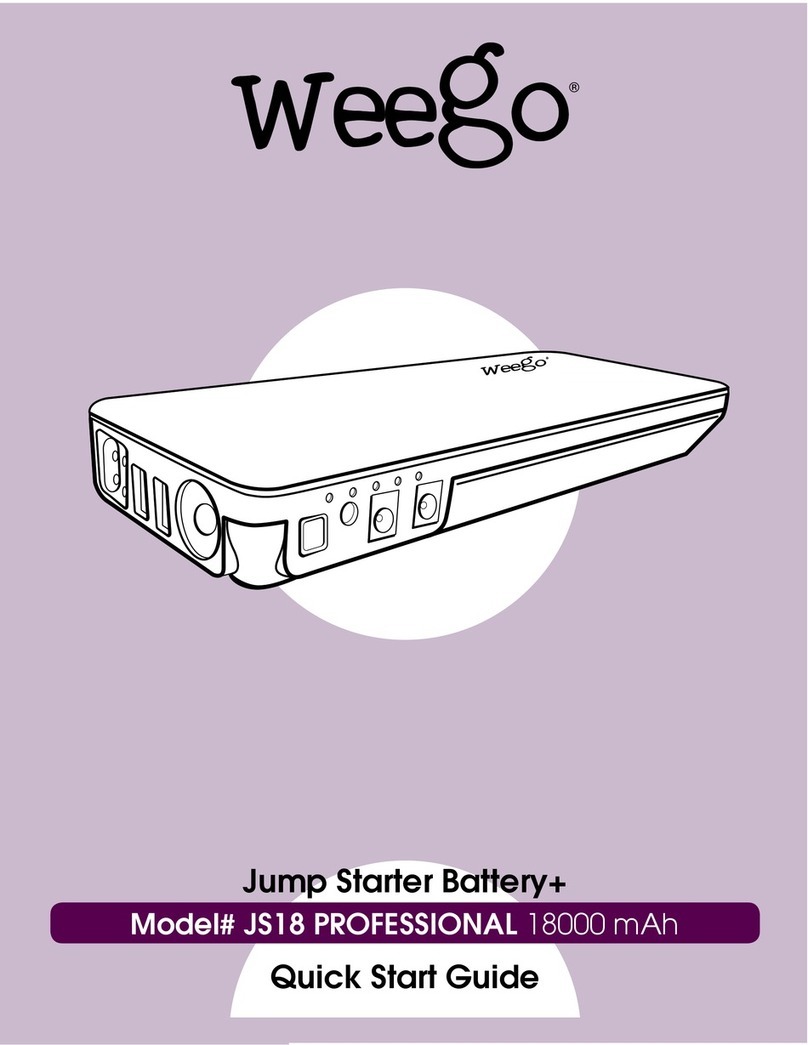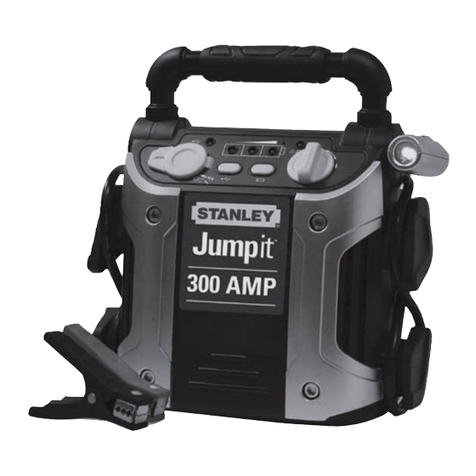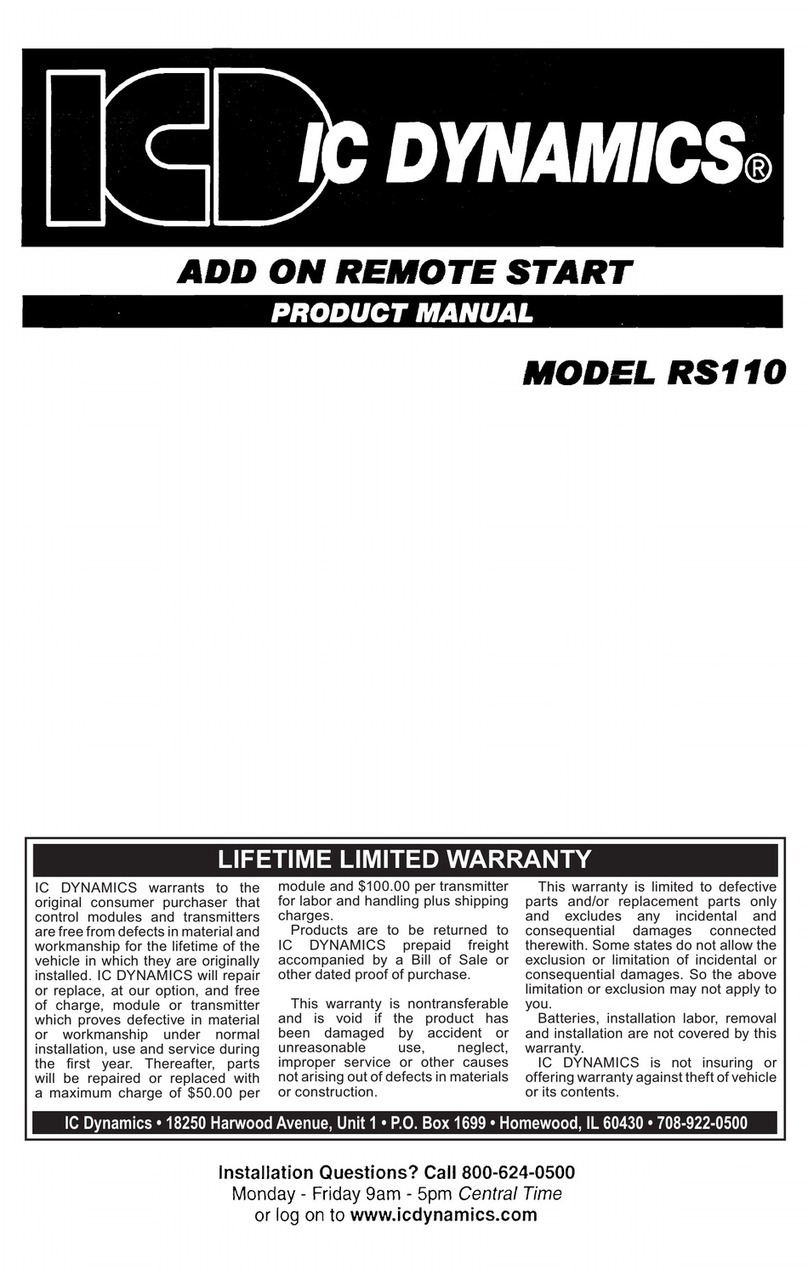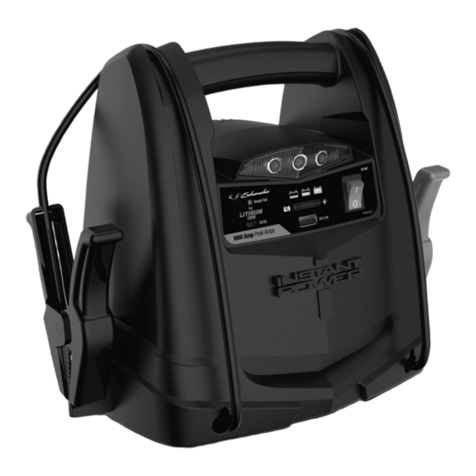Prologix SOLAR PL3760 User manual

SOLAR PL3760
Operator’s Manual
WARNING
Read these instructions completely before using the SOLAR Battery Charger and save them for
future reference. Before using the SOLAR Battery Charger to charge a battery, read these
instructions and the instruction manual/safety information provided by the car, truck, boat or
equipment manufacturer. Following all manufacturers’ instructions and safety procedures will
reduce the risk of accident.
Working around lead-acid batteries may be dangerous. Lead-acid batteries release explosive gases
during normal operation, charging and jump starting. Carefully read and follow these instructions for
safe use. Always follow the specific instructions in this manual and on the SOLAR Battery Charger
each time you use the SOLAR Battery Charger.
All lead-acid batteries (car, truck and boat) produce hydrogen gas which may violently explode in
the presence of fire or sparks. Do not smoke, use matches or a cigarette lighter while near
batteries. Do not handle the battery while wearing vinyl clothing because static electricity sparks
are generated when vinyl clothing is rubbed. Review all cautionary material on the SOLAR Battery
Charger and in the engine compartment.
Always wear eye protection, appropriate protective clothing and other safety equipment when
working near lead-acid batteries. Do not touch eyes while working on or around lead-acid batteries.
Always store clamps away from each other or common conductors. Improper storage of clamps
may cause the clamps to come in contact with each other, or a common conductor, which would
be hazardous if the charger was plugged into an AC outlet.
Use extreme care while working within the engine compartment, because moving parts may cause
severe injury. Read and follow all safety instructions published in the vehicle's Owner's Manual.
Batteries being charged with the SOLAR Battery Charger unit likely contain liquid acids which are
hazardous if spilled.
Failure to follow instructions may cause
damage or explosion, always shield eyes.
Read entire instruction manual before use.
WARNING
Includes information on SOLAR Model No. PL3760
Part No. 141-396-000
Warning: This product can expose you to chemicals,
including Vinyl-Chloride, Styrene and Acrylonitrile, which
are known to the State of California to cause cancer.

2
SAFETY SUMMARY
IMPORTANT SAFETY INSTRUCTIONS
SAVE THESE INSTRUCTIONS
SAVE THESE INSTRUCTIONS – This manual contains important safety and operating instructions for
Model No. PL3760.
WARNING
Read these instructions completely before using the SOLAR Battery Charger and save them for
future reference. Before using the SOLAR Battery Charger to charge a battery, read these
instructions and the instruction manual/safety information provided by the car, truck, boat or
equipment manufacturer. Following all manufacturers’ instructions and safety procedures will
reduce the risk of accident.
Working around lead-acid batteries may be dangerous. Lead-acid batteries release explosive gases
during normal operation, charging and jump starting. Carefully read and follow these instructions for
safe use. Always follow the specific instructions in this manual and on the SOLAR Battery Charger
each time you use the SOLAR Battery Charger.
All lead-acid batteries (car, truck and boat) produce hydrogen gas which may violently explode in
the presence of fire or sparks. Do not smoke, use matches or a cigarette lighter while near
batteries. Do not handle the battery while wearing vinyl clothing because static electricity sparks
are generated when vinyl clothing is rubbed. Review all cautionary material on the SOLAR Battery
Charger and in the engine compartment.
Always wear eye protection, appropriate protective clothing and other safety equipment when
working near lead-acid batteries. Do not touch eyes while working on or around lead-acid batteries.
Always store clamps away from each other or common conductors. Improper storage of clamps
may cause the clamps to come in contact with each other, or a common conductor, which would
be hazardous if the charger was plugged into an AC outlet.
Use extreme care while working within the engine compartment, because moving parts may cause
severe injury. Read and follow all safety instructions published in the vehicle's Owner's Manual.
Batteries being charged with the SOLAR Battery Charger unit likely contain liquid acids which are
hazardous if spilled.
Failure to follow instructions may cause
damage or explosion, always shield eyes.
Read entire instruction manual before use.
WARNING
Please read and retain these instructions for the continued safe use of your new charger. This manual contains
important safety information. DO NOT OPERATE this equipment UNTIL YOU HAVE READ this safety summary!
WARNING: Changes or modifications to this unit not expressly approved by the party responsible for
compliance could void the user’s authority to operate the equipment.
NOTE: This device complies with Part 15 of the FCC Rules. Operation is subject to the following two
conditions: (1) this device may not cause harmful interference, and (2) this device must accept any
interference received, including interference that may cause undesired operation.
This Class B industrial apparatus complies with Canadian ICES-003.

3
WARNING – Shock Hazards
1. NEVER attempt to charge a marine (boat) battery while the boat is on or near the water. A boat
must be on a trailer and located indoors before attempting to charge its battery(s). The boat
manufacturer’s battery charging instructions must be followed exactly.
2. NEVER set the charger, output cable or clamps, or AC power cord plug in water or on wet surfaces.
3. NEVER use this charger on a pier or dock. Charger could fall in water, creating an electric shock
hazard.
4. NEVER attempt to plug in or operate the battery charger with defective or damaged wires, power
cord, or power cord plug. Have any of these parts that are defective or damaged replaced by
qualified personnel IMMEDIATELY.
5. NEVER attempt to plug in the charger or operate its controls with wet hands or while standing in
water.
6. NEVER alter the AC power cord or power cord plug provided with the battery charger.
7. NEVER use an attachment not recommended or sold by Clore Automotive for use with this specific
model battery charger. Use of such attachment may result in risk of fire, electric shock or injury to
persons.
8. NEVER operate this battery charger if it has received a sharp blow, been dropped, or similarly
damaged, until after being inspected and/or repaired by qualified service personnel.
9. NEVER disassemble this battery charger. Take the battery charger to qualified service personnel
when service or repair is needed. Incorrect reassembly may result in a risk of electric shock or fire.
10. ALWAYS plug in and unplug the AC power cord by grasping the power cord plug, NOT THE
POWER CORD, to reduce risk of damaging power cord.
11. ALWAYS unplug the battery charger from the AC outlet before attempting any cleaning or
maintenance. Turning the charger’s control(s) OFF, alone, will not remove all electricity from the
charger, and will not reduce this risk.
12. An extension cord should not be used unless absolutely necessary. Use of an improper extension
cord could result in a fire or electric shock. If an extension cord must be used, make sure that:
a. That pins on plug of extension cord are the same number, size, and shape as those of plug on charger;
b. That extension cord is properly wired and in good electrical condition; and
c. That the wire size is large enough for the length of cord as specified below:
Length of cord in feet: 25 50 100 150
AWG size of cord: 16 12 10 8
WARNING – Risk of Explosive Gases
1. WORKING IN THE VICINITY OF A LEAD-ACID BATTERY IS DANGEROUS. BATTERIES GENERATE
EXPLOSIVE GASSES DURING NORMAL OPERATIONS AND, AT AN EVEN HIGHER LEVEL,
DURING CHARGING. IF ANYTHING IS ALLOWED TO IGNITE THESE GASSES, THE BATTERY
MAY EXPLODE, SENDING PIECES OF THE BATTERY AND EXTREMELY CAUSTIC BATTERY ACID
OUT IN ALL DIRECTIONS AND WITH EXTREME FORCE. SINCE JUST THE SLIGHTEST SPARK
IS SUFFICIENT TO IGNITE THESE GASSES, IT IS OF UTMOST IMPORTANCE THAT YOU READ
THIS MANUAL AND FOLLOW THE INSTRUCTIONS EXACTLY, BEFORE USING YOUR BATTERY
CHARGER.
2. NEVER operate this battery charger near any fuel tanks or gas cylinders. This charger can produce
sparks that could ignite gasses and cause an explosion.
3. NEVER attempt to permanently mount this battery charger on a marine or recreational vehicle.
4. NEVER attempt to connect this charger’s output cables directly to the battery(s) in the bilge or
engine compartment of a boat. Follow the boat manufacturer’s battery charging instructions exactly.

4
WARNING – Battery Explosion Hazards
1. NEVER connect both battery charger clamps directly to the two posts of the same battery. See
Operation Instructions for connection procedures.
2. NEVER allow the DC output clamps to touch each other.
3. ALWAYS be extra cautious to reduce the risk of dropping a metal object, such as a tool, onto or
near the battery. Doing so could produce a spark or short circuit the battery or other electrical part
that could cause an explosion.
4. NEVER operate the battery charger in a closed-in area or restrict ventilation in any way.
5. ALWAYS make sure the area around a battery is well ventilated while it is being charged. Gas can
be forcefully blown away by using a piece of cardboard or other non-metallic material as a fan.
6. ALWAYS make sure that the AC power cord is unplugged from the AC outlet or extension cord
BEFORE connecting or disconnecting the battery charger clamps, to prevent arcing or burning.
7. ALWAYS locate the battery charger as far away from the battery as the DC output cables will
permit.
8. ALWAYS twist or rock charger clamps back and forth several times on the battery post and
the other point of connection at the time of initial connection. This helps keep the clamps from
slipping off their points of connection which helps reduce the risk of sparking. DO NOT rock the
clamp connected to the battery post AFTER the second connection (at a point away from the
battery) is made or sparking may occur at the battery post.
9. ALWAYS check the cable and wire connections at the battery(s) for tightness BEFORE starting to
charge. A loose connection can cause sparks or excessive heating which could cause a battery
explosion.
10. ALWAYS make sure the battery compartment is open and well ventilated before charging.
WARNING – Moving Parts Hazards
1. NEVER connect the battery charger clamps to a vehicle when the engine is running.
2. ALWAYS stay clear of fan blades, fan belts, pulleys and other moving engine parts when working
near an engine. Moving engine parts can cause severe personal injury, including dismemberment.
3. ALWAYS make sure that the battery charger cables and clamps are positioned so they will not
come in contact with any moving engine parts.
4. NEVER wear loose clothing or long hair around moving parts because they may get caught and
cause severe injury or death.
WARNING – Burn Hazards
1. NEVER lean on or rest against the engine or cooling system parts when the vehicle is running.
2. ALWAYS stay clear of the cooling system, engine, and engine manifold. These engine
components get very hot and retain heat for a long time. Touching any of these components can
cause severe burns.
3. Never connect the clamps to a battery before confirming that the output cables are securely
connected to the unit.
WARNING
Read these instructions completely before using the Battery Charger and save them for future
reference. Before using the Battery Charger to charge a battery, read these instructions and the
instruction manual/safety information provided by the car, truck, boat or equipment manufacturer.
Following all manufacturers’ instructions and safety procedures will reduce the risk of accident.
Working around lead-acid batteries may be dangerous. Lead-acid batteries release explosive gases
during normal operation, charging and jump starting. Carefully read and follow these instructions for
safe use. Always follow the specific instructions in this manual and on the Battery Charger each
time you use the Battery Charger.
All lead-acid batteries (car, truck and boat) produce hydrogen gas which may violently explode in
the presence of fire or sparks. Do not smoke, use matches or a cigarette lighter while near
batteries. Do not handle the battery while wearing vinyl clothing because static electricity sparks
are generated when vinyl clothing is rubbed. Review all cautionary material on the Battery Charger
and in the engine compartment.
Always wear eye protection, appropriate protective clothing and other safety equipment when
working near lead-acid batteries. Do not touch eyes while working on or around lead-acid batteries.
Always store clamps away from each other or common conductors. Improper storage of clamps
may cause the clamps to come in contact with each other, or a common conductor, which would
be hazardous if the charger was plugged into an AC outlet.
Use extreme care while working within the engine compartment, because moving parts may cause
severe injury. Read and follow all safety instructions published in the vehicle's Owner's Manual.
Batteries being charged with the Battery Charger unit likely contain liquid acids which are
hazardous if spilled.
Failure to follow instructions may cause
damage or explosion, always shield eyes.
Read entire instruction manual before use.
WARNING

5
PERSONAL PRECAUTIONS
1. Someone should be within range of your voice or close enough to come to your aid when you work near a
lead-acid battery.
2. Have plenty of fresh water and soap nearby in case battery acid contacts skin, clothing or eyes.
3. Wear complete eye protection and clothing protection. Avoid touching eyes while working near battery.
4. If battery acid contacts skin or clothing, wash immediately with soap and water. If acid enters eye,
immediately flood eye with running cold water for at least 10 minutes and get medical attention
immediately.
5. NEVER smoke or allow a spark or flame in vicinity of battery or engine.
6. Be extra cautious to reduce risk of dropping a metal tool onto battery. It might spark or short-circuit
battery or other electrical part that may cause explosion.
7. Remove personal metal items such as rings, bracelets, necklaces and watches when working with a lead-
acid battery. A lead-acid battery can produce a short-circuit current high enough to weld a ring or other
jewelry to metal, causing a severe burn.
8. Use charger for charging LEAD-ACID batteries only. It is not intended to supply power to a low voltage
electrical system other than in a starter-motor application. Do not use battery charger for charging dry-cell
batteries that are commonly used with home appliances. These batteries may burst and cause injury to
persons and damage to property.
9. NEVER charge a frozen battery, as battery explosion can result.

6
INTRODUCTION
Description
This battery charger is designed to handle the majority of your charging and starting needs. It features:
• Automatic Multi-Phase Charging mode for easy operation.
• The ability to properly charge multiple battery types, including Flooded, AGM and Spiral Wound batteries.
• Multiple Charge Rates for various battery sizes.
• High-Amperage Engine Starting Assistance to start vehicles when the battery is weak.
• A stable power mode to maintain vehicle system voltage during on-vehicle repairs.
• Large Saw-Tooth Clamps assure good connection to top or side-mount battery terminals.
• Heavy-Duty Construction for long, trouble-free life.
How Batteries Charge
A battery charger does not force current into a battery – it makes a specific amount of current available to the
battery and the battery draws as much of it as it needs, up to or slightly greater than the rated output current
capability of the charger.
The closer a battery is to zero capacity (dead battery), the more charging current it will want to draw. When
charging begins, on a dead battery, the charger will typically supply current at or very near the nominal chosen
charging rate, and then move to a reduced rate of current as the battery becomes more fully charged. Keep in
mind, a charger’s display shows the amount of current being drawn from the charger by the battery, not what the
charger is capable of delivering.
Note: A slow, intermittent bubbling sound may be heard coming from the battery during the charging process.
This is a normal condition and just another indicator the battery is being charged.
To reduce the risk of battery overcharging, it is important to thoroughly read this entire instruction manual.
How Stable Power Mode Functions
Your unit features 3 separate working modes: automatic battery charging mode, stable power mode, and engine
start mode.
Stable Power mode is used to hold the voltage of the electrical system on a vehicle at a constant voltage for
various service/maintenance functions. These include on-vehicle repairs of electronically controlled systems,
diagnosis of electrical system component function or other applications where it is detrimental for the system
voltage to drop below a specific threshold.
In stable power mode, your unit will provide power to the vehicle’s electrical system so that system voltage
remains at a steady level (as directed by you during stable power mode set-up) despite load changes the system
experiences up to 60A (12V mode) 20A (24V mode) over an extended period of time.
NOTE: Stable power mode utilizes the vehicle’s battery to improve response times to load changes. As such, it
is important to ensure the vehicle’s battery is in good condition and fully charged prior to initiating stable power
mode.
Spark Prevention
Make sure no sparks or flames occur near the battery, especially during charging. It takes very little to ignite the
explosive gasses produced by a lead-acid battery during the charging process. Read, understand and follow the
safety information provided in the Safety Summary section of this manual before attempting to work with or near a
lead-acid battery.

7
ASSEMBLY
Assemble the Handle
Assemble the charger handle according to the following instructions and illustrations.
1. Carefully remove the charger
unit and all associated
hardware from carton.
2. Unscrew the two screws on
either side of the charger as
shown in Figure 1. They are
the screws nearest to the
top and towards the rear
of the unit.
3. The charger is shipped with the handle partially secured
and resting in a down position on the front of the unit.
Lift the handle on its axis, up and over the front of the
charger into a vertical position, perpendicular to the top
of the unit.
4. Align the holes in the handle with the screw holes on the
side of the charger (the same holes from which you just
removed the two screws in step 2). Secure the two screws
back into their original holes, thus securing the handle
(Figure 3).
Figure 1. Remove the screws
Remove the Screws
Figure 2. Lift the handle
Lift the Handle Into Position
Figure 3. Secure the handle
Secure the Handle

8
Charger Placement
Place the charger in a clean, dry, stable, well-ventilated spot as far from the battery as the DC output cables
permit.
NEVER place the charger directly above the battery being charged - gasses from the battery will corrode and
damage the charger.
NEVER allow battery acid to drip on the charger when reading specific gravity or filling the battery.
NEVER place a battery on top of the charger.
NEVER attempt to permanently mount this battery charger on a marine or recreational vehicle.
ALWAYS position the charger on the outside of a boat or recreational vehicle.
Provide Required Power
This battery charger requires a nominal 120V 60Hz alternating current (AC) power source. The power source must
be fused at an amperage greater than or equal to the input amps rating of this charger - see back of unit for input
power requirements.
Do not plug the charger into the AC power source until told to do so in the operating instructions.
NOTE: Engine starting performance may be reduced when extension cords are used.
WARNING: ELECTRIC SHOCK CAN KILL!
See Safety Summary, pages 2-5.
To reduce risk of electric shock, never alter AC power cord or power cord plug provided on the charger. If it will
not fit the outlet, have a proper outlet installed by a qualified electrician. Never use an adapter.
The charger must be grounded to reduce risk of electric shock. The charger is equipped with an electric cord
that has an equipment grounding plug. The plug must be plugged into an AC outlet that is properly installed and
grounded in accordance with all local codes and ordinances.
Extension Cords
An extension cord should not be used unless absolutely necessary. If necessary, care must be taken to select an
extension cord suitable for use with your specific battery charger (see Shock Hazards in Safety Summary).
WARNING: Fire can kill, injure and cause property damage!
See Safety Summary, pages 2-5.
To reduce risk of electric shock and fire, never alter the AC power cord or power cord plug provided on the
charger. Never alter extension cords or extension cord plugs. Make sure the extension cord is properly wired and
in good electrical condition. Make sure the wire size (American Wire Gauge or AWG) of the extension cord is large
enough to handle your specific charger’s amperage requirements. This battery charger features protection against
abnormally low input voltage and will safely shut the charger down if input voltage is too low.
Battery Preparation
WARNING: Battery explosion can injure and cause property damage! Never smoke or allow a spark
or flame in the vicinity of the battery or engine.
See Safety Summary, pages 2-5.
If it is necessary to remove the battery from the vehicle to charge it, make sure all accessories in the vehicle are off
and always remove the grounded cable from the battery first.
If needed, add distilled water to each cell of the battery until battery acid reaches the manufacturer’s specified
level. DO NOT OVERFILL! This helps remove excessive explosive gasses from the battery. For maintenance free
batteries without caps, carefully follow the battery manufacturer’s recharging instructions.
WARNING
Read these instructions completely before using the Battery Charger and save them for future
reference. Before using the Battery Charger to charge a battery, read these instructions and the
instruction manual/safety information provided by the car, truck, boat or equipment manufacturer.
Following all manufacturers’ instructions and safety procedures will reduce the risk of accident.
Working around lead-acid batteries may be dangerous. Lead-acid batteries release explosive gases
during normal operation, charging and jump starting. Carefully read and follow these instructions for
safe use. Always follow the specific instructions in this manual and on the Battery Charger each
time you use the Battery Charger.
All lead-acid batteries (car, truck and boat) produce hydrogen gas which may violently explode in
the presence of fire or sparks. Do not smoke, use matches or a cigarette lighter while near
batteries. Do not handle the battery while wearing vinyl clothing because static electricity sparks
are generated when vinyl clothing is rubbed. Review all cautionary material on the Battery Charger
and in the engine compartment.
Always wear eye protection, appropriate protective clothing and other safety equipment when
working near lead-acid batteries. Do not touch eyes while working on or around lead-acid batteries.
Always store clamps away from each other or common conductors. Improper storage of clamps
may cause the clamps to come in contact with each other, or a common conductor, which would
be hazardous if the charger was plugged into an AC outlet.
Use extreme care while working within the engine compartment, because moving parts may cause
severe injury. Read and follow all safety instructions published in the vehicle's Owner's Manual.
Batteries being charged with the Battery Charger unit likely contain liquid acids which are
hazardous if spilled.
Failure to follow instructions may cause
damage or explosion, always shield eyes.
Read entire instruction manual before use.
WARNING
PREPARATION

9
WARNING: Battery acid can cause serious injury and property damage!
See Safety Summary, pages 2-5.
Always wear complete eye and clothing protection and avoid touching eyes while working near battery.
Clean battery terminals. Be careful to keep corrosion from coming in contact with eyes.
Study all of the battery manufacturer’s precautions, such as whether cell caps should be left in place or removed
during charging, and the recommended rates of charge for the specific battery. If you are unable to determine the
battery manufacturer’s requirements for charging, always charge the battery with cell caps in place at the lowest
charging rate available.
If the battery voltage cannot be determined from the information on the battery itself, refer to the owner’s manual
for the product in which the battery was installed. Since the charger has adjustable charge rate, charge battery
initially at lowest rate.
The Ability to Charge Multiple Battery Types
Traditional battery chargers utilize basic charging controls that make them appropriate for charging only
Conventional and Maintenance Free Flooded (wet) Cell batteries. Use of traditional battery chargers on AGM or
other modern batteries results in suboptimal charging and potential harm to the battery being charged.
PRO-LOGIX Charger models utilize advanced charging technology to deliver precise charge controls, enabling them
to properly charge a wide variety of battery types.
Soft Start Mode and Battery Repair Mode
PRO-LOGIX Charger models utilize a proprietary advanced Multi-Phase charging process designed to optimally
charge many types of batteries. One critical aspect of this proprietary process is the precise control achieved
through the charging process, enabling the charger to monitor a battery’s specific reaction to the power supplied.
The PRO-LOGIX charging process includes a Soft Start Mode to properly charge deeply discharged batteries and
ensure that the energy from the charger is being properly incorporated into the battery. It also includes a Battery
Repair Mode to attempt to restore batteries that do not properly accept charging current. The display will indicate
BATTERY REPAIR by flashing the CHARGING LED and and monitor current acceptance by the battery. Battery
charging time will be extended to allow the battery to recover. Both processes are fully automatic and require no
intervention on the part of the operator, either to initiate the process or complete it.
Locating the Charger
1. Locate the charger as far away from the battery as DC cables permit.
2. Never allow battery acid to drip on the charger when reading specific gravity or filling the battery.
3. Do not operate the charger in a closed area or restrict ventilation in any way.
4. Ensure that there that there are no obstructions to the air flow, so the internal fans can properly cool the unit.
5. Do not set a battery on top of the charger.
6. Do not place the charger where rain, snow, or other moisture could drip on it.

10
MODE Selection Button
The Mode selection button changes the mode
of operation of the charger between AUTO
CHARGE mode, ENGINE START mode, and
STABLE POWER mode. In Auto Charge mode,
once the charging parameters have been set
and the START button has been pressed, the
charger will commence a proprietary, advanced
multi-phase charging sequence designed to
provide an optimal charge. STABLE POWER
mode provides steady, stable power to
maintain system voltage during on-vehicle
repairs and other applications where it is
detrimental for system voltage to drop below
a specific threshold. ENGINE START mode provides engine starting assistance to jump start vehicles with
depleted batteries.
SUPPLY (Stable Power) Control Buttons
Once an operator chooses SUPPLY Mode, they are able to select the desired system voltage to be maintained.
Desired voltage can be increased or decreased in 0.1V increments
CHARGE Control Buttons
Once an operator chooses CHARGE Mode, there are additional settings that must be chosen prior to
commencing the charging sequence.
The Type button allows an operator to choose the specific battery type to be charged, enabling the charger
to provide the exact power profile for that battery type. Selectable battery types include traditional flooded
batteries and AGM batteries (including Spiral Wound batteries).
The Volt button allows the operator to choose the desired voltage for the specific application. Selectable
voltages include 12V and 24V.
The Rate button allows an operator to choose the desired charge rate for each specific application. Selectable
charge rates include 60A, 40A or 10A charge rates (12V mode), 20A and 10A charge rates (24V mode)..
START Button
The START button is used to commence each function once all of the functional parameters have been set to
the desired values. The START button can also be used to discontinue any function once it has commenced.
LED Status Lights
LED lights in the control panel indicate which functional mode the charger is currently set to, as well as current
status of the chosen function once the function has commenced. In addition, each function mode features
error LEDs to alert the operator to unsafe operating conditions, including battery faults and reverse polarity
connections.
CONTROLS AND INDICATORS

11
Choosing a Charging Rate
Choose a charging rate that is appropriate for the size and type of battery being charged. Use the battery
manufacturer’s specific instructions or see the guidelines below.
Typical rates are:
Small Motorcycle/Powersport 5 Amps or less (not applicable to this charger)
Lawn Mower/Tractor 5 Amps or less (not applicable to this charger)
Deep Cycle 15 Amps or less
Maintenance Free Automotive or Marine Cranking 40 Amps or less
Heavy Duty Commercial 60 Amps or less
Do not exceed the maximum charge rate recommended by the battery manufacturer or the chart above.
Choosing a Battery Type Setting
PRO-LOGIX Charger models utilize advanced charging technology to deliver precise charge controls, enabling them
to properly charge a wide variety of battery types.
• For Conventional and Maintenance Free Flooded (wet) Cell batteries: Choose STANDARD (STD).
• For AGM batteries: Choose AGM.
• For Spiral Wound Batteries: Choose AGM.
For batteries identified as Deep Cycle or Marine batteries, determine the construction of the battery. Is it a Wet cell,
AGM or Spiral Wound type of construction? Battery construction will determine the proper battery type selection.
Pre-Charge Battery Activation
Some modern batteries can cause charging problems if they have been deeply discharged. The plates in these
batteries can begin sulfating quickly, forming a barrier to accepting a charge. This condition will be indicated
by an extremely low (or zero) ammeter reading, indicating that the battery is not accepting current from the
charger. A deeply discharged battery such as this may take as long as 4 to 8 hours before it will accept a charge.
The Automatic Charging mode attempts to detect batteries with this condition (see Battery Repair Mode in
PREPARATION) and automatically adjusts for it.
.

12
Operating Instructions
ATTENTION: Do not attempt to operate this battery charger until you have read and understood the entire Safety
Summary provided in this manual.
Connecting to Batteries Installed in Vehicles
ATTENTION: Do not plug the charger power cord into the AC power source or set any of the charger’s controls
until told to do so in the following instructions.
ATTENTION: Connect and disconnect DC output clips only after setting any charger switches to “OFF” position
and removing AC cord from electric outlet. Never allow clips to touch each other.
1. Make sure that the AC power cord is unplugged from the AC outlet and make sure the vehicle’s engine is
turned off.
2. Position the AC power cord and DC output cables in such a manner that they cannot be damaged by
moving engine parts or the vehicle’s hood or doors.
3. Check the polarity of the battery terminals. The POSITIVE terminal should be marked POSITIVE, POS, + or
P. The NEGATIVE terminal should be marked NEGATIVE, NEG, – or N.
4. Determine whether the vehicle has a positive or negative grounded battery (positive or negative cable is
connected to the vehicle’s chassis).
WARNING: Moving engine parts can cause serious injury! Stay clear of fan blades, belts, pulleys and
other moving engine parts to reduce risk of serious personal injury.
a. Negative Ground Vehicles (most common, see Figure 5)
1) Connect the POS (red, +) clamp from the battery charger to the POS, ungrounded terminal of the
battery.
2) Connect the NEG (black, –) clamp from the battery charger to a
heavy gauge metal part of the vehicle chassis or engine block away
from the battery. DO NOT connect the NEG charger clamp to the NEG
battery terminal, carburetor, fuel lines or sheet metal body parts.
b. Positive Ground Vehicles
1) Connect the NEG (black) charger clamp to the NEG, ungrounded
terminal of the battery.
2) Connect the POS (red) charger clamp to a heavy gauge metal part
of the vehicle chassis or engine block away from the battery. DO NOT
connect the POS (red) charger clamp to the POS battery terminal,
carburetor, fuel lines or sheet metal body parts.
5. When disconnecting charger, turn switches to off, disconnect AC cord,
remove clip form vehicle chassis and then remove clip from battery terminal.
Connecting to Batteries Outside a Vehicle
1. Make sure that the AC power cord is unplugged from the AC power source.
2. Check the polarity of the battery terminals (see Figure 6). The
POSITIVE terminal should be marked POSITIVE, POS, + or P. The
NEGATIVE terminal should be marked NEGATIVE, NEG, – or N.
3. Attach a battery or booster cable, AT LEAST 24 inches long, that
is the same (or larger) wire gauge as the charger cable, to the
NEGATIVE terminal of the battery.
WARNING: Battery explosion can injure, and cause property
damage! To reduce the risk of battery explosion, NEVER
connect both battery charger clamps directly to the two posts
of a battery.
4. Connect the POS (red) charger clamp to the POS battery terminal.
Negative
Ground Vehicle
Negative to
Chassis Ground
Positive
Connecting Outside a Vehicle
From
Charger
Positive (+)
Charger
Cable
Negative (ñ)
Charger
Cable
Booster
Cable
OPERATION

13
5. Position yourself and the free end of the cable (attached to the NEG battery terminal) as far away from
the battery as the cable will allow. Then, WHILE FACING AWAY FROM THE BATTERY, connect the
NEGATIVE charger clamp to the free end of the cable.
6. When disconnecting charger, turn switches to off, disconnect AC cord and disconnect charger, always
in reverse sequence of connecting procedure and break first connection while as far away from battery
as practical.
Charging Mode Operation
ATTENTION: Do not plug the charger power cord into the AC power source or set any of the charger’s controls
until told to do so in the following instructions.
ATTENTION: Connect and disconnect DC output clamps only after setting the power switch to the “OFF”
position and unplugging the AC cord from electric outlet. Never allow clamps to touch each other.
ATTENTION: Do not operate the charger in a closed area or restrict ventilation in any way. Ensure that there that
there are no obstructions to the air flow, so the internal fans can properly cool the unit.
Make a proper battery connection (see Connecting to a Battery Sections as applicable) and plug AC power cord
into an AC receptacle. Then, turn the master power switch to ON. The charger is now in Standby Mode.
In order to place the unit into Charging Mode, toggle the Mode Selection button until the CHARGE LED is lit. If an
ERROR Indicator LED lights, disconnect from AC stable power immediately and determine the cause of the alarm.
The POLARITY light indicates reverse polarity error connection, while the ERROR light indicates the detection of a
battery fault, such as a shorted connection.
1. Choose a battery type setting. To charge Standard and Maintenance Free Flooded Acid batteries, push the
Battery Type button until the “STD” LED is lit. To charge AGM and Spiral Wound batteries, push the Battery
Type button until the “AGM” LED is lit.
2. Choose a battery charging rate. Please see Choosing a Charge Rate section for general details related to
choosing a charging rate for your application.
3. Press the START button and the charging indicator LED will light. The charger will automatically commence
and complete the charging process. If you press the START button at any point during the charging sequence,
the charger will stop charging and return to Standby Mode.
Note: If the ERROR LED lights, disconnect from AC power immediately and determine the cause of the issue. See
Additional Features for a list of conditions that might cause an error.
Note: The charger is designed to protect against faults and shorts (see Battery Charger Features). If the battery
to be charged has a open circuit voltage of less than 1V, the charger will indicate a fault. If, after unplugging unit,
checking connections and verifying all settings, you determine the problem causing the “fault” condition is battery
voltage below 1V, you can override the charger’s protection by holding down the “START” button for 3 seconds.
The charger will commence the charging sequence and, assuming these are no other hindrances that caused the
fault indication, will complete the charging process and automatically turn off when the battery has reached full
charge.
4. When the battery approaches full charge and enters the Completion Phase, the green CHARGING COMPLETE
indicator will light and the CHARGING indicator will flash. At this point, if time is critical, the battery can be put
into service if it will be used in a charging situation, such as in a vehicle that that will be used immediately. To
reach a true 100% state of charge, the charger should stay connected until the charger reaches the Rest Phase,
when only the green CHARGING COMPLETE LED is lit.

14
5. After charging is complete, press the START button to return the unit to Standby Mode, turn off the Master Power
Switch and unplug the charger from the AC power source. Then, disconnect the charger clamp not connected
directly to the battery first and DO NOT allow the clamp to touch anything. Then, disconnect the charger clamp
attached to the battery terminal. (See Connecting To Batteries... at the beginning of this section.)
Stable Power Mode Operation
ATTENTION: Do not plug the charger power cord into the AC power source or set any of the charger’s controls
until told to do so in the following instructions.
ATTENTION: Connect and disconnect DC output clamps only after setting the power switch to the “OFF” position
and unplugging the AC cord from electric outlet. Never allow clamps to touch each other.
ATTENTION: Do not operate the charger in a closed area or restrict ventilation in any way. Ensure that there that
there are no obstructions to the air flow, so the internal fans can properly cool the unit.
Make a proper battery connection (see Connecting to a Battery in a Vehicle Section) and plug AC power cord into
an AC receptacle. Then, turn the master power switch located on the back of the unit to ON. The charger is now in
Standby Mode.
In order to place the unit into Stable Power Mode, toggle the Mode Selection button until the SUPPLY LED is
lit. If an ERROR Indicator LED lights, disconnect from AC stable power immediately and determine the cause of
the alarm. The POLARITY light indicates reverse polarity error connection, while the ERROR light indicates the
detection of a battery fault, such as a shorted connection.
NOTE: Make sure that the vehicle battery is in good condition and fully charged. A compromised battery can
jeopardize your diagnostic or repair efforts.. The unit will not commence the Stable Power mode if the vehicle
battery is below 12.0VDC. Charge the battery first to ensure it has capacity.
1. Choose the desired system voltage level. Using the UP/DOWN arrows in the Stable Power mode voltage control
zone, set the system voltage level on the display to the desired voltage.
2. Press the START button. The charger will bring system voltage to the desired level and hold it at that level,
providing power as needed (60A in 12V mode, 20A in 24V mode) to the vehicle to maintain the desired level. If
you press the START button at any point during the Stable Power sequence, the charger will stop charging and
return to Standby Mode.
3. After the Stable power session is complete, press the START button to return the unit to Standby Mode,
turn off the Master Power Switch and unplug the charger from the AC power source. Then, disconnect the
charger clamp not connected directly to the battery first and DO NOT allow the clamp to touch anything. Then,
disconnect the charger clamp attached to the battery terminal. (See Connecting To Batteries... at the beginning
of this section.)

15
Engine Starting
This battery charger can provide a high-current output to help start a 12V vehicle with a weak battery. However,
the onboard computer in some vehicles can be damaged when attempting to jump start. ALWAYS READ THE
VEHICLE OPERATOR’S MANUAL BEFORE AUXILIARY STARTING to determine if jump starting can do damage to
the vehicle. If not, read and follow these instructions.
CAUTION: Do not try to boost start a vehicle that does not contain a battery or you may damage electrical systems
in the vehicle.
1. Connect the battery charger to the vehicle according to the Connecting to a Battery Section of this
manual.
2. Charge the battery for 5 to 10 minutes at the appropriate charge rate for the size of battery.
3. In order to place the unit into Engine Start mode, toggle the Mode Selection button until the START LED is
lit. Press Start.
Note: The charger will enter Engine Start mode and stay in that mode for 30 seconds. If a start attempt is
not made within 30 seconds, the charger will return to standby mode.
4. Try to start the vehicle. If the vehicle doesn’t start after 3 to 4 seconds, stop and wait 3 to 4 minutes.
Repeat until engine starts.
5. After the engine start session is complete, press the START button to return the unit to Standby Mode,
turn off the Master Power Switch and unplug the charger from the AC power source. Then, disconnect the
charger clamp not connected directly to the battery first and DO NOT allow the clamp to touch anything.
Then, disconnect the charger clamp attached to the battery terminal. (See Connecting To Batteries... at the
beginning of this section.)
CAUTION: Excessive continuous engine cranking can damage vehicle starter motors.
Note: If the engine spins but fails to start after several starting attempts, there is an engine problem not related to the
starting system. Discontinue cranking the engine until the other problem is found and corrected.
This battery charger has an internal thermal protector to prevent overheating and damage to the battery charger.
After starting attempt, wait 3 to 4 minutes for the charger to cool. The thermal protector will automatically reset and
allow you to continue.
Charging Amp Settings
Voltage Charging Rate Power Supply Engine Start
12V 60/40/10A 60A Max 250A
24V 20/10A 20A Max –––

MAINTENANCE
CAUTION: Make sure charger is unplugged from AC outlet before performing any cleaning or maintenance.
1. Inspect clamps after each use for any damage that may have occurred. to prevent corrosion. Battery fluid
may be neutralized with a solution of water and baking soda.
2. Wipe off any battery fluid that may have come in contact with the clamps to prevent corrosion. Battery
fluid may be neutralized with a solution of water and baking soda.
3. Disconnect output cables from unit after each use and protect the terminals. Protect the input cable from
damage.
4. Make sure case venting is open and unobstructed allowing the air to flow freely.
5. If needed, the case may be wiped clean with a dry, soft cloth.
Moving and Storage
1. Always disconnect from AC power source when placing the unit into storage.
2. Store unit indoors in a clean, dry environment.
3. Always store and transport the unit upright to prevent damage.
TROUBLESHOOTING
No display and the LEDs are not lit.
1. Unit has a low-power mode, pressing any button will exit the low-power mode.
2. Check that input power cord is plugged in at both the unit and the receptacle.
3. Check that the power switch is turned ON.
4. Check power at receptacles.
Display reads 0.0V.
1. Make sure that the positive clamp is making good connection to the positive battery terminal.
2. Make sure that the negative clamp is making good connected to a grounded point on the chassis.
3. If you have verified all connections are correct, the problem may be that the battery is severely discharged.
In this case you can press and hold the START button for at least 3 seconds, but no more than 10
seconds, to override and start a charge.
Unit unexpectedly and inappropriately reduces output.
1. The unit has thermal protection. In an overheat condition, it will reduce the output power to protect itself.
2. Make sure that the fans are properly working and that there are no obstructions to the air flow.
Battery does not accept charge.
1. Make sure charger is plugged into properly functioning AC outlet.
2. After unplugging unit, check connection at battery. Make sure the clamps are making good contact with
the battery terminal (or vehicle chassis).
3. Check to see that the battery is capable of being charged – it may be damaged or sulfated.
4. Make sure that you have selected the proper charge voltage for the battery being charged.
5. Make sure you are allowing enough time for charging the battery.
Vehicle will not start in engine start mode.
1. Unplug charger and check connections as described above.
2. Determine if charger is charging; if display indicates increasing voltage at the battery, charger is working; if
no charging progress is indicated, wait several minutes and recheck.
3. If engine turns over but does not start, problem is with vehicle, not charger. Service vehicle.
See Limited Warranty for further information on obtaining service.
When it comes to quality battery chargers & jump starters, Solar is the brand you can depend on.
Other manuals for SOLAR PL3760
1
Table of contents
Other Prologix Remote Starter manuals
Popular Remote Starter manuals by other brands
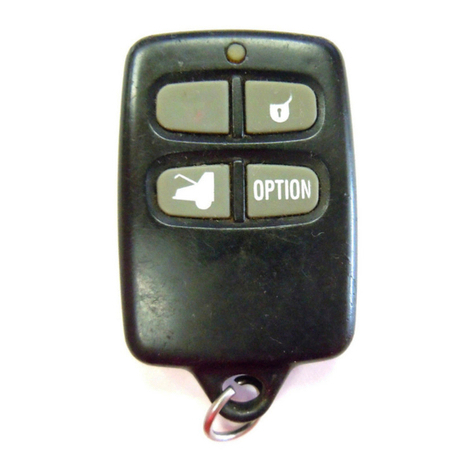
Audiovox
Audiovox Pursuit PRO-9675FT4 installation instructions
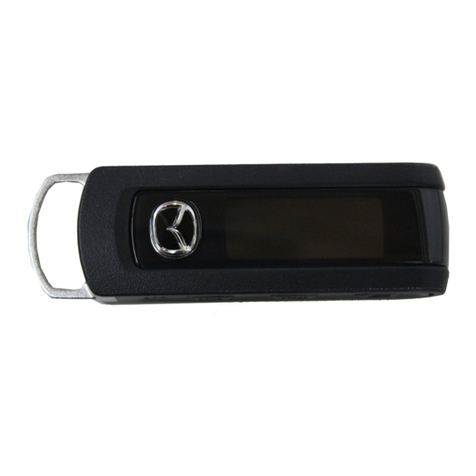
Mazda
Mazda PZ170-04021 User instructions
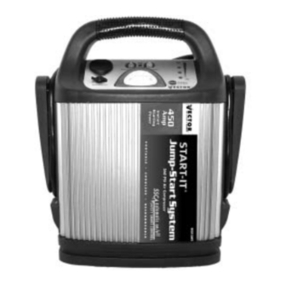
Vector
Vector Start-IT VEC012APC Owner's manual & warranty
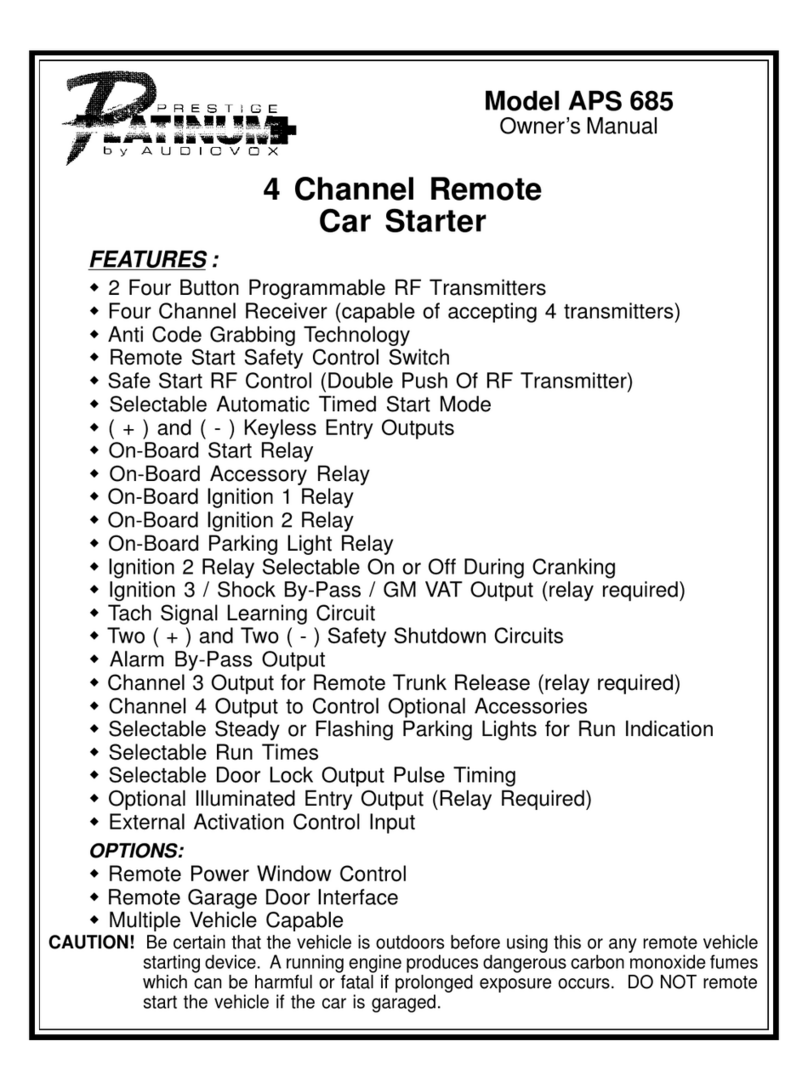
Audiovox
Audiovox APS 685 owner's manual

Clarke
Clarke Jumpstart 900 operating & maintenance manual
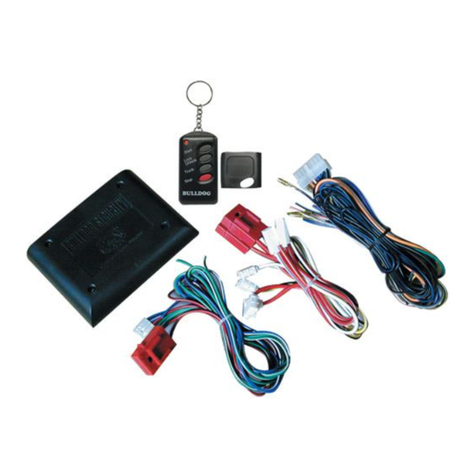
Bulldog Security
Bulldog Security RS1100 Installation and owner's guide
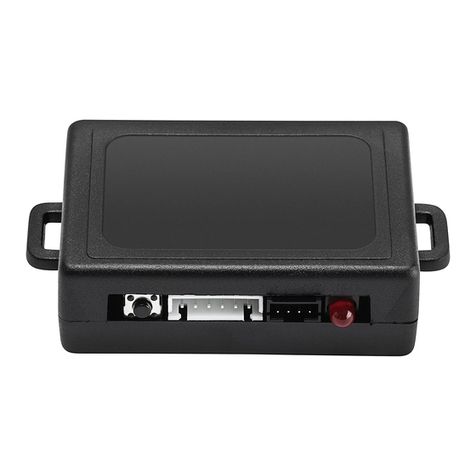
Fortin
Fortin KEY-OVERRIDE-ALL SUGGESTED WIRING CONFIGURATION
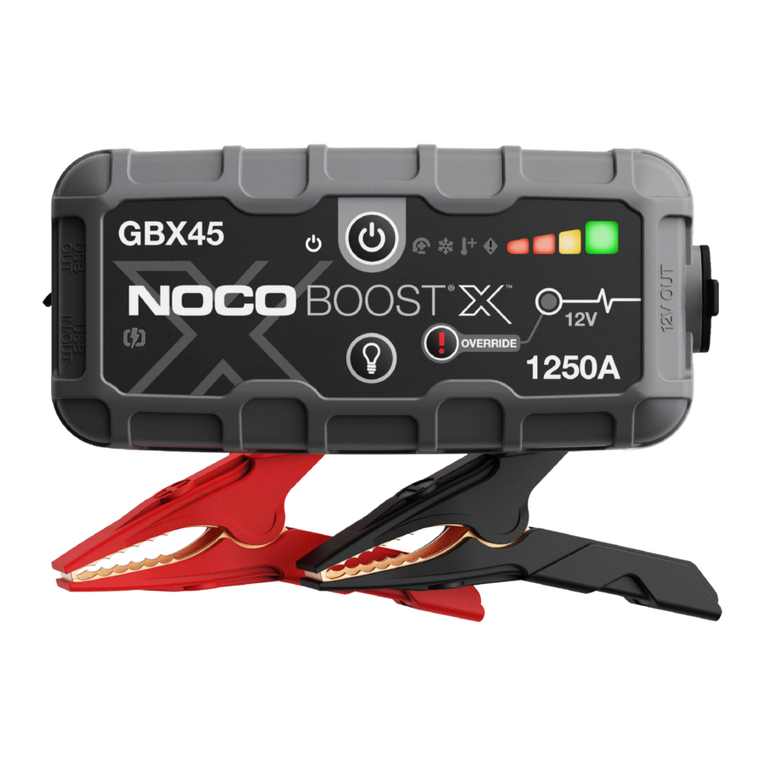
NOCO Genius
NOCO Genius BOOST X GBX45 User guide & warranty
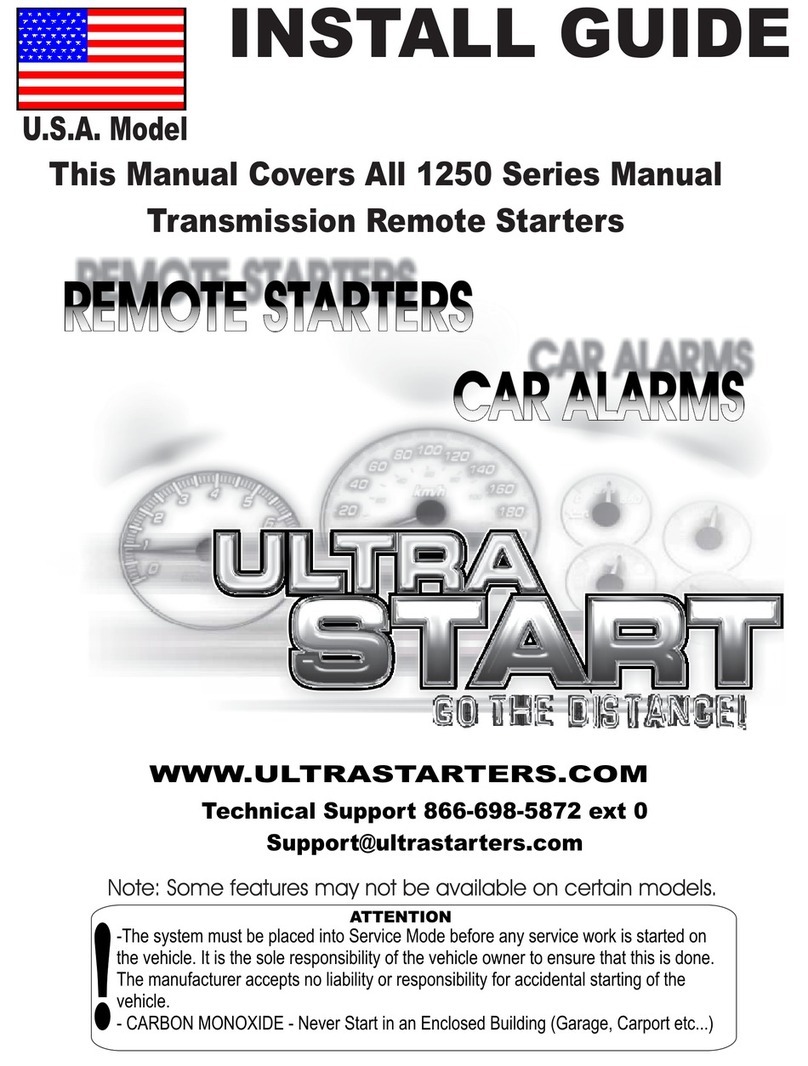
Ultra Start
Ultra Start 1250 SERIES install guide
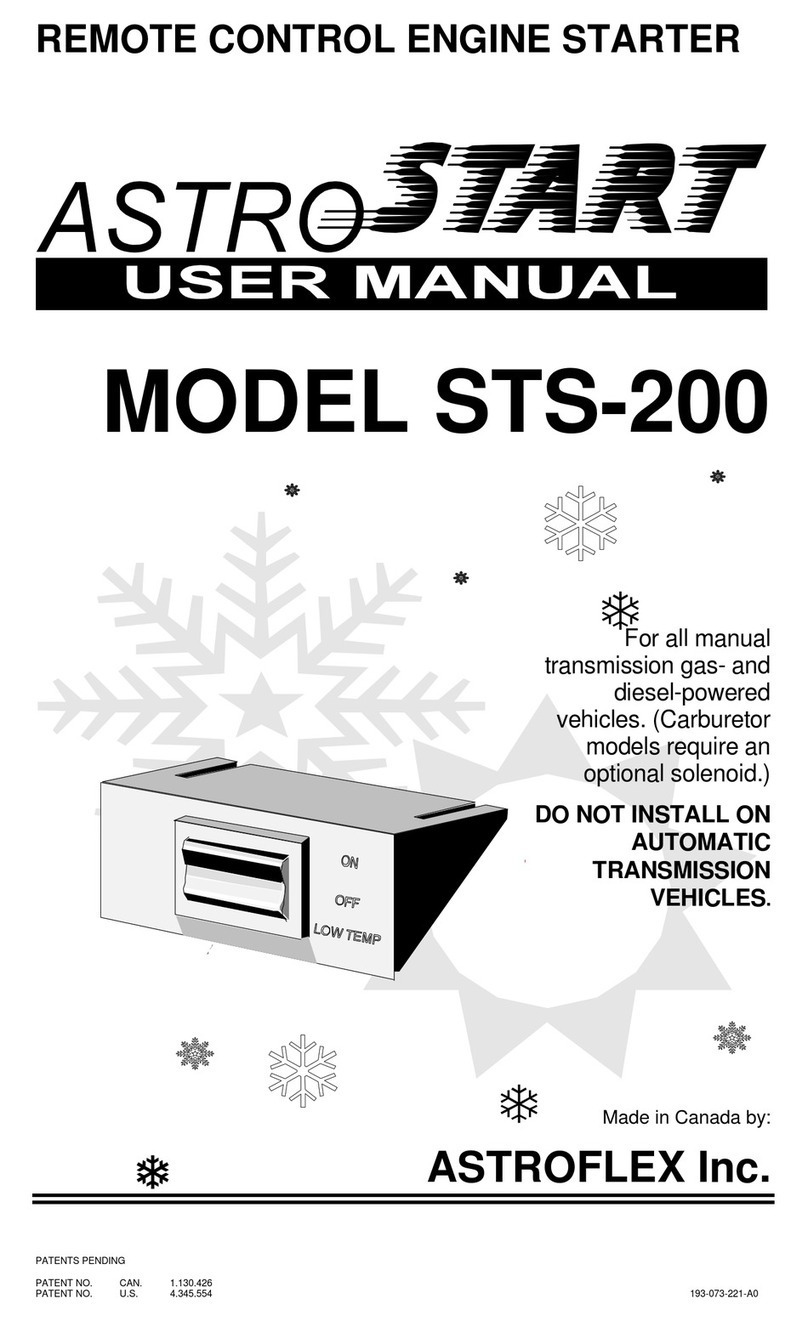
AstroStart
AstroStart STS-200 user manual
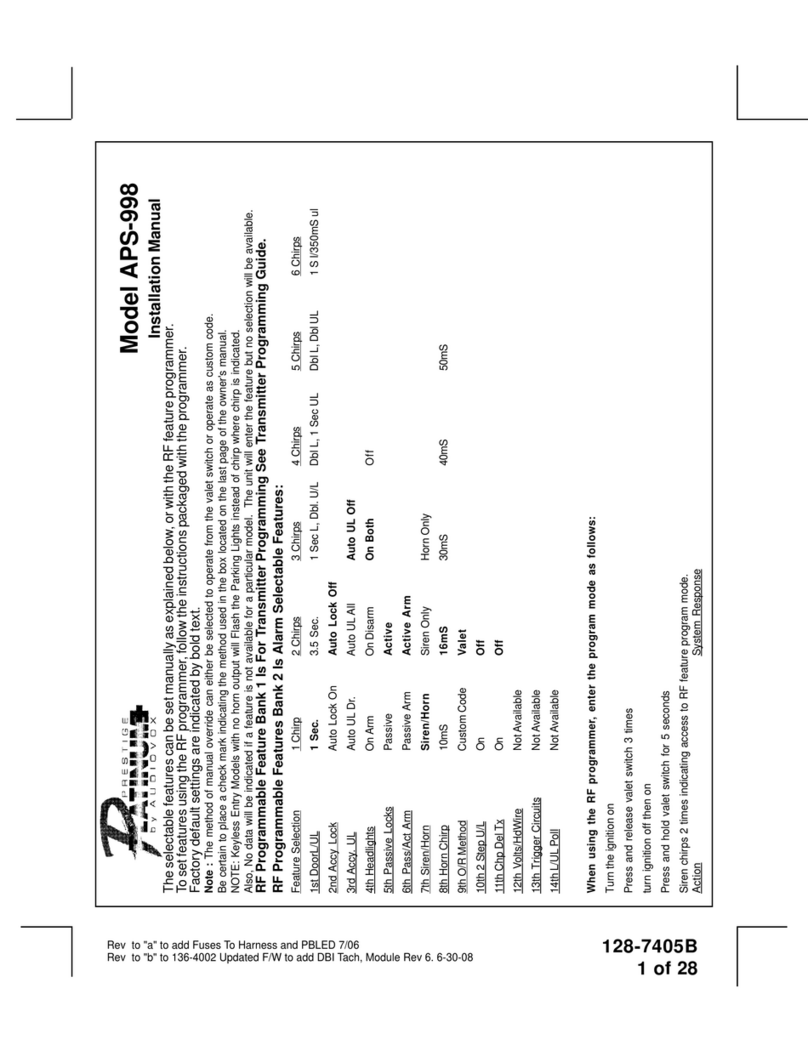
Prestige
Prestige Prestige Platinum 128-7405B installation manual

Directed
Directed 3000 series owner's guide
